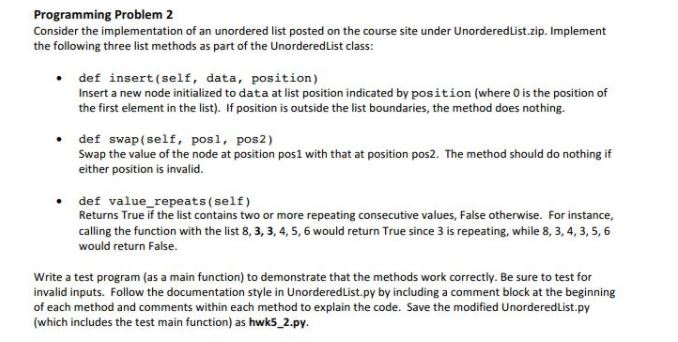Question
# Implementation of an Unordered List ADT as a linked list. The list # is accessed through a reference to the first element, head. #
# Implementation of an Unordered List ADT as a linked list. The list # is accessed through a reference to the first element, head. # Adopted from Section 3.9 of the textbook.
from Node import Node
class UnorderedList: ''' List is empty upon creation and the head reference is None ''' def __init__(self): self.head = None ''' Returns True if list is empty, False otherwise ''' def is_empty(self): return self.head == None ''' Add an element to head of the list ''' def add(self, item): # Create a node using item as its data temp = Node(item) # make the next reference of the new node refer to the head # of the list temp.set_next(self.head) # modify the list head so that it references the new node self.head = temp ''' Returns the size of the list ''' def size(self): # start at the head of the list current = self.head count = 0 # Traverse the list one element at a time. We know # we reached the end when the next reference is None while current != None: count = count + 1 current = current.get_next() return count
''' Search for an item in the list. Returns True if found, False otherise. ''' def search(self,item): current = self.head found = False # As long as the element is not found and we haven't # reached the end of the list while current != None and not found: if current.get_data() == item: found = True else: # go to the next element current = current.get_next() return found ''' Remove the first occurrence of item from the list. ''' def remove(self, item): # keep track of current and previous elements current = self.head previous = None found = False # traverse the list while current != None and not found: # if we have a match, stop if current.get_data() == item: found = True # otherwise advance current and next references else: previous = current current = current.get_next() # the element to be deleted is the head of the list if found: if previous == None: self.head = current.get_next() # the element to be deleted is not the head else: previous.set_next(current.get_next()) def main(): # create a list and add some elements to it aList = UnorderedList() print("Adding 3, 5, 8, and 11 to the list.") aList.add(3) aList.add(5) aList.add(8) # 11 is the head of the list aList.add(11) print("List size:", aList.size()) print("Is 5 in the list? ", aList.search(5)) print("Removing 5 from the list.") aList.remove(5) print("Is 5 in the list? ", aList.search(5)) print("List size:", aList.size()) print("Removing 3 from the list.") aList.remove(3) print("List size:", aList.size()) if __name__ == "__main__": main()
Step by Step Solution
There are 3 Steps involved in it
Step: 1

Get Instant Access to Expert-Tailored Solutions
See step-by-step solutions with expert insights and AI powered tools for academic success
Step: 2

Step: 3

Ace Your Homework with AI
Get the answers you need in no time with our AI-driven, step-by-step assistance
Get Started


